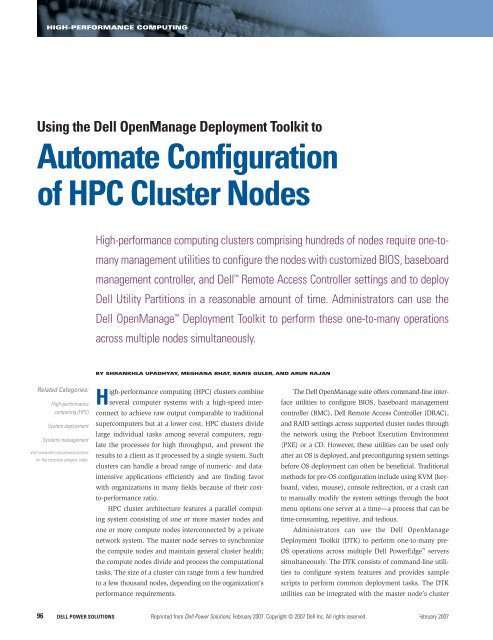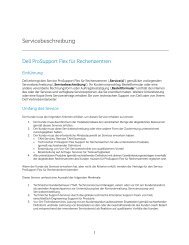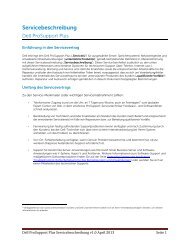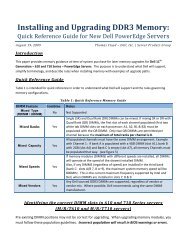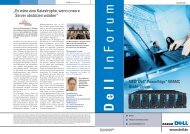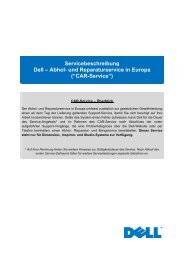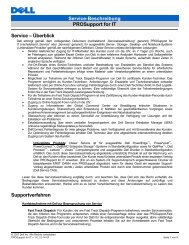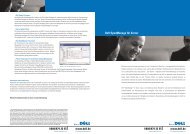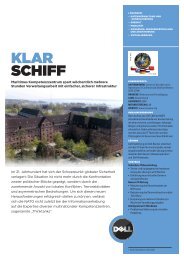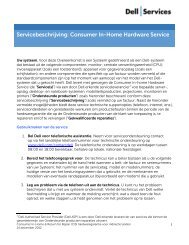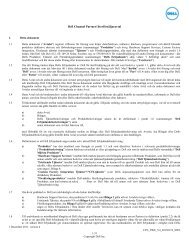Automate Configuration of HPC Cluster Nodes - Dell
Automate Configuration of HPC Cluster Nodes - Dell
Automate Configuration of HPC Cluster Nodes - Dell
You also want an ePaper? Increase the reach of your titles
YUMPU automatically turns print PDFs into web optimized ePapers that Google loves.
96<br />
HIGH-PERFORMANCE COMPUTING<br />
Using the <strong>Dell</strong> OpenManage Deployment Toolkit to<br />
<strong>Automate</strong> <strong>Configuration</strong><br />
<strong>of</strong> <strong>HPC</strong> <strong>Cluster</strong> <strong>Nodes</strong><br />
Related Categories:<br />
High-performance<br />
computing (<strong>HPC</strong>)<br />
System deployment<br />
Systems management<br />
Visit www.dell.com/powersolutions<br />
for the complete category index.<br />
High-performance computing clusters comprising hundreds <strong>of</strong> nodes require one-tomany<br />
management utilities to configure the nodes with customized BIOS, baseboard<br />
management controller, and <strong>Dell</strong> Remote Access Controller settings and to deploy<br />
<strong>Dell</strong> Utility Partitions in a reasonable amount <strong>of</strong> time. Administrators can use the<br />
<strong>Dell</strong> OpenManage Deployment Toolkit to perform these one-to-many operations<br />
across multiple nodes simultaneously.<br />
BY SHRANKHLA UPADHYAY, MEGHANA BHAT, BARIS GULER, AND ARUN RAJAN<br />
High-performance computing (<strong>HPC</strong>) clusters combine<br />
several computer systems with a high-speed interconnect<br />
to achieve raw output comparable to traditional<br />
supercomputers but at a lower cost. <strong>HPC</strong> clusters divide<br />
large individual tasks among several computers, regulate<br />
the processes for high throughput, and present the<br />
results to a client as if processed by a single system. Such<br />
clusters can handle a broad range <strong>of</strong> numeric- and dataintensive<br />
applications efficiently and are finding favor<br />
with organizations in many fields because <strong>of</strong> their costto-performance<br />
ratio.<br />
<strong>HPC</strong> cluster architecture features a parallel computing<br />
system consisting <strong>of</strong> one or more master nodes and<br />
one or more compute nodes interconnected by a private<br />
network system. The master node serves to synchronize<br />
the compute nodes and maintain general cluster health;<br />
the compute nodes divide and process the computational<br />
tasks. The size <strong>of</strong> a cluster can range from a few hundred<br />
to a few thousand nodes, depending on the organization’s<br />
performance requirements.<br />
The <strong>Dell</strong> OpenManage suite <strong>of</strong>fers command-line interface<br />
utilities to configure BIOS, baseboard management<br />
controller (BMC), <strong>Dell</strong> Remote Access Controller (DRAC),<br />
and RAID settings across supported cluster nodes through<br />
the network using the Preboot Execution Environment<br />
(PXE) or a CD. However, these utilities can be used only<br />
after an OS is deployed, and preconfiguring system settings<br />
before OS deployment can <strong>of</strong>ten be beneficial. Traditional<br />
methods for pre-OS configuration include using KVM (keyboard,<br />
video, mouse), console redirection, or a crash cart<br />
to manually modify the system settings through the boot<br />
menu options one server at a time—a process that can be<br />
time-consuming, repetitive, and tedious.<br />
Administrators can use the <strong>Dell</strong> OpenManage<br />
Deployment Toolkit (DTK) to perform one-to-many pre-<br />
OS operations across multiple <strong>Dell</strong> PowerEdge servers<br />
simultaneously. The DTK consists <strong>of</strong> command-line utilities<br />
to configure system features and provides sample<br />
scripts to perform common deployment tasks. The DTK<br />
utilities can be integrated with the master node’s cluster<br />
DELL POWER SOLUTIONS Reprinted from <strong>Dell</strong> Power Solutions, February 2007. Copyright © 2007 <strong>Dell</strong> Inc. All rights reserved. February 2007
management s<strong>of</strong>tware and then pushed onto individual client nodes<br />
without configuring each node individually. This article describes<br />
how the DTK can be used in a Linux ® OS environment for typical<br />
configuration tasks performed on <strong>HPC</strong> clusters before the deployment<br />
<strong>of</strong> the cluster package as well as during maintenance tasks.<br />
It also discusses techniques for configuring BIOS, BMC, and DRAC<br />
settings and installing the <strong>Dell</strong> Utility Partition; these techniques can<br />
be scaled to include other DTK configuration features.<br />
Using the <strong>Dell</strong> OpenManage Deployment Toolkit<br />
in <strong>HPC</strong> clusters<br />
The life cycle <strong>of</strong> a typical <strong>HPC</strong> cluster can be divided into several<br />
phases, with different management tasks in each phase. The deployment<br />
phase involves remote power management, which is provided<br />
by the BMC and requires setting up parameters in the BMC options<br />
menu such as IP address, netmask, user ID, and password. The<br />
operational phase involves cluster health monitoring, which requires<br />
both in-band and out-<strong>of</strong>-band mechanisms be in place. To enable<br />
these mechanisms, BMC options such as username, password, and<br />
LAN alert destination and BIOS options such as boot sequence,<br />
snoop filter, Demand-Based Switching, logical processor, and console<br />
redirection settings must be configured.<br />
On ninth-generation servers, the DTK allows administrators to<br />
modify most configuration parameters <strong>of</strong> the remote system, specifically<br />
the BIOS, BMC, and DRAC 5 settings. Administrators can use the<br />
DTK syscfg tool to capture and replicate these settings. Alternatively,<br />
administrators can use an automated script to capture a complete list<br />
<strong>of</strong> BIOS and BMC settings and use this list as a comparison when<br />
troubleshooting problems such as failed nodes and performance<br />
declines. The DTK can help provide a safe preinstallation OS environment<br />
for performing necessary operations during the deployment <strong>of</strong><br />
an <strong>HPC</strong> cluster, helping reduce the time spent manually configuring<br />
each node in the cluster. Figure 1 outlines some DTK features and<br />
associated commands relevant to cluster deployment.<br />
Setting up the <strong>Dell</strong> OpenManage Deployment Toolkit<br />
environment<br />
The DTK is available in two versions: a Micros<strong>of</strong>t ® Windows ®<br />
Preinstallation Environment (WinPE) self-extractable zip file and<br />
a Red Hat ® Enterprise Linux 3 ISO image. Administrators can<br />
extract the WinPE tools and scripts obtained from the zip file and<br />
build them into a WinPE image. Administrators can also extract<br />
the tools and scripts from the Linux ISO image and use them<br />
in a customized ISO image, or use the image provided with the<br />
DTK. The information provided in this article refers to the Linux<br />
version <strong>of</strong> the DTK.<br />
Administrators can set up the DTK environment in a cluster<br />
using the PXE mechanism available on the master node. The PXE<br />
environment allows servers (in this case, the compute nodes) to<br />
HIGH-PERFORMANCE COMPUTING<br />
boot over a network connection. As each compute node boots into<br />
the lightweight Linux environment provided by the DTK through<br />
PXE from the master node, it executes the automated scripts that<br />
perform the required operations on the system.<br />
Installation prerequisites are as follows:<br />
• DTK 2.x CD (created by downloading the DTK ISO image<br />
from support.dell.com and burning the image on a CD)<br />
• Master node running Linux or a Linux-based OS<br />
• Compute nodes connected to the master node and ready<br />
to install<br />
Setting up the DTK environment on the master node<br />
A wide variety <strong>of</strong> cluster management s<strong>of</strong>tware is available, and<br />
administrators can use the DTK to configure basic BIOS, BMC,<br />
DRAC, and RAID settings on different types <strong>of</strong> <strong>Dell</strong> Linux clusters.<br />
Administrators must configure the Trivial FTP (TFTP) server on the<br />
master node; the directory used to serve files is typically the /tftpboot<br />
directory. The DTK kernel file (SA.1) and ramdisk file (SA.2), available<br />
with the DTK download, must be copied to the master node<br />
/tftpboot directory.<br />
After the DTK CD is mounted on the server, the files can be<br />
copied to the /tftpboot directory using the following commands:<br />
mount /dev/cdrom /mnt/cdrom<br />
cp /mnt/cdrom/isolinux/SA.1 /tftpboot/SA.1<br />
cp /mnt/cdrom/isolinux/SA.2 /tftpboot/SA.2<br />
umount /mnt/cdrom<br />
Administrators must also create a folder on the Network File<br />
System (NFS) share <strong>of</strong> the master node. In the example scripts<br />
shown in this article, /export/home/install/dtk carries the default<br />
sample scripts provided with the DTK as well as any custom scripts<br />
written for specific server configurations.<br />
Finally, administrators must place an entry for the DTK in the<br />
standard master node PXE configuration file for all the compute nodes<br />
to obtain the DTK kernel and ramdisk images over PXE. Figure 2<br />
shows an example PXE configuration file. The IP address <strong>of</strong> the<br />
master node (for the private network <strong>of</strong> the cluster) is set to 10.1.1.1.<br />
Additional examples for different types <strong>of</strong> shares are available in the<br />
isolinux.cfg file provided with the DTK Linux ISO image.<br />
Installing the <strong>Dell</strong> Utility Partition<br />
The <strong>Dell</strong> Utility Partition is a bootable partition on the hard drive<br />
that contains diagnostic and system utilities. The partition is typically<br />
between 32 MB and 60 MB. Installing the partition requires<br />
the latest <strong>Dell</strong> Utility Partition images, which are provided by <strong>Dell</strong><br />
OpenManage Server Assistant (available on the <strong>Dell</strong> Installation and<br />
Server Management CD that ships with PowerEdge servers).<br />
www.dell.com/powersolutions Reprinted from <strong>Dell</strong> Power Solutions, February 2007. Copyright © 2007 <strong>Dell</strong> Inc. All rights reserved. DELL POWER SOLUTIONS 97
HIGH-PERFORMANCE COMPUTING<br />
98<br />
DTK option Get example Set example Description<br />
Asset syscfg --asset syscfg --asset=node1 Sets the asset tag value, which can<br />
only be assigned programmatically; <strong>Dell</strong><br />
OpenManage Server Assistant and the<br />
DTK enable administrators to assign this<br />
information<br />
Boot sequence syscfg --bootseq syscfg --bootseq=3,2,1 Sets the node boot sequence<br />
LCD syscfg --lcd<br />
syscfg --lcd1<br />
syscfg --lcd2<br />
Intel ® Hyper-Threading<br />
Technology<br />
syscfg --lcd=user<br />
syscfg --lcd1="Change HDD"<br />
Sets the PowerEdge server LCD to reflect<br />
information about the server<br />
syscfg --logicproc syscfg --logicproc=enable Enables or disables the logical processor<br />
Power button syscfg --powerbutton syscfg --powerbutton=disable Enables or disables the node power button<br />
USB ports syscfg --usbports syscfg --usbports=disable Enables or disables USB ports<br />
Adjacent cache line<br />
prefetcher<br />
syscfg --adjcacheprefetch syscfg --adjcacheprefetch=enable Enables or disables cache line prefetch settings<br />
to help enhance system performance<br />
Hardware prefetcher syscfg --hwprefetcher syscfg --hwprefetcher=disable Enables or disables hardware prefetch settings<br />
to help enhance system performance<br />
LAN syscfg lancfgparams syscfg lcp<br />
--alertdest=1<br />
--destipaddr=192.168.0.101<br />
--nicselection=dedicated<br />
--dnsserver1=192.168.0.100<br />
--dnsracname=rac-dell<br />
LAN users syscfg lanuseraccess syscfg lua<br />
--userid=2<br />
--usrprivlmt=administrator<br />
Platform Event Filter<br />
(PEF)<br />
Demand-Based<br />
Switching (DBS)<br />
Network interface<br />
card (NIC)<br />
syscfg pefcfgparams syscfg pcp<br />
--filter=powerfail<br />
--filteralert=enable<br />
Configures and displays LAN configuration<br />
parameters<br />
Configures the privilege level and channel<br />
accessibility associated with a specified<br />
user ID for the LAN channel<br />
Configures and displays PEF configuration<br />
parameters<br />
syscfg --dbs syscfg --dbs=enable Enables or disables DBS; can help minimize<br />
power and cooling requirements<br />
syscfg --embnic1 syscfg --embnic1=on<br />
syscfg --embnic2=onnopxe<br />
Configures the embedded NIC ports to<br />
enable or disable PXE and turn NIC ports<br />
on or <strong>of</strong>f<br />
Snoop filter syscfg --snoopfilter syscfg --snoopfilter=enable Enables or disables the snoop filter<br />
option on supported systems<br />
Figure 1. System parameters configurable with the DTK<br />
label dtk<br />
kernel SA.1<br />
append initrd=SA.2 ramdisk_size=36817 Stage3_type=cdrom DEBUG=0 quiet<br />
ide=force_255_heads share_type=nfs share_location=10.1.1.1:/export/home/install/dtk share_script=dtk.sh<br />
share_opts=nolock<br />
Figure 2. Example PXE configuration file<br />
DELL POWER SOLUTIONS Reprinted from <strong>Dell</strong> Power Solutions, February 2007. Copyright © 2007 <strong>Dell</strong> Inc. All rights reserved. February 2007
svctag='syscfg --svctag | awk -F= '{print $2}''<br />
sysname='syscfg --sysname | awk -F= '{print $2}' | cut –c11-14'<br />
./upinit.sh --overwrite –disk=/dev/sda –size=32 –file=../../systems/UP/2800/upimg.bin<br />
Figure 3. Sample dtk.sh script<br />
syscfg --bootseq=cdrom.emb.0,floppy.emb.0,hdd.emb.0,nic.emb.1<br />
syscfg --logicproc=disable<br />
syscfg --snoopfilter=enable<br />
syscfg --dbs=enable<br />
syscfg --embnic1=on<br />
syscfg --embnic2=onnopxe<br />
Figure 4. Sample dtk.sh script snippet for BIOS configuration<br />
syscfg lancfgparams --ipaddress 10.0.0.3 --subnetmask 255.0.0.0<br />
syscfg lancfgparams --alertdest=1 --destipaddr=10.0.0.20<br />
syscfg lancfgparams --nicselection=dedicated<br />
Figure 5. Sample dtk.sh script snippet for BMC and DRAC configuration<br />
The compute nodes must install the partition before installing<br />
the <strong>HPC</strong> cluster management s<strong>of</strong>tware. Therefore, during instal-<br />
lation, the preferred label in the PXE configuration file, default,<br />
under the master node /tftpboot/pxelinux/pxelinux.cfg folder is<br />
changed to dtk, causing the compute nodes to boot from the DTK<br />
image for the installation <strong>of</strong> the <strong>Dell</strong> Utility Partition. Administrators<br />
can make the compute nodes boot from the master node PXE setup<br />
by pressing F12 as the nodes start to boot.<br />
The dtk.sh script, a sample <strong>of</strong> which is shown in Figure 3, is<br />
used to install the <strong>Dell</strong> Utility Partition; this script should be placed<br />
in the NFS share at /export/home/install/dtk. Once the <strong>Dell</strong> Utility<br />
Partition installation is complete on all compute nodes, the master<br />
node label is changed back to the original label, and the standard<br />
cluster installation can proceed normally.<br />
Capturing and modifying system configuration settings<br />
Administrators can capture or modify BIOS, BMC, and DRAC<br />
settings using DTK commands such as those shown in Figure 1.<br />
To capture all system configuration settings accessible by the<br />
DTK, administrators can use the syscap.sh script, available at<br />
/export/home/install/dtk/template/scripts, as a default template.<br />
Figures 4 and 5 show example script snippets that administrators<br />
can incorporate into the main dtk.sh automated script file.<br />
HIGH-PERFORMANCE COMPUTING<br />
Configuring cluster nodes with the <strong>Dell</strong><br />
OpenManage Deployment Toolkit<br />
The <strong>Dell</strong> OpenManage Deployment Toolkit can<br />
help administrators perform a wide range <strong>of</strong><br />
server configuration tasks on large <strong>HPC</strong> clusters.<br />
Using DTK features and its preconfigured scripts<br />
in a pre-OS environment can help simplify the<br />
setup and configuration <strong>of</strong> critical server parameters<br />
in both homogenous and heterogeneous<br />
<strong>HPC</strong> clusters, with the ultimate goal <strong>of</strong> helping<br />
improve data center deployment, management,<br />
and administration, and eventually total cost<br />
<strong>of</strong> operation.<br />
Shrankhla Upadhyay is an engineering analyst in<br />
the Scalable Systems Group at <strong>Dell</strong>. Her current<br />
interests include <strong>HPC</strong> cluster management, operating<br />
systems, and cluster file systems. She has a B.E. in<br />
Computer Science from Birla Institute <strong>of</strong> Technology and<br />
Science, Pilani.<br />
Meghana Bhat is a senior engineer in the Deployment team in the <strong>Dell</strong><br />
OpenManage Product Group. Her areas <strong>of</strong> interest include open source<br />
s<strong>of</strong>tware and standards. She has worked on <strong>Dell</strong> OpenManage Server<br />
Assistant and is currently working on the <strong>Dell</strong> OpenManage Deployment<br />
Toolkit. Meghana has a B.E. in Computer Science from Vishwakarma<br />
Institute <strong>of</strong> Technology, Pune.<br />
Baris Guler is an <strong>HPC</strong> application specialist in the Scalable Systems<br />
Group at <strong>Dell</strong>. His current research interests are parallel processing,<br />
diskless <strong>HPC</strong> clusters, performance benchmarking, reservoir engineering<br />
and simulation, and numerical methods. Baris has a B.S. in Petroleum and<br />
Natural Gas Engineering (PNGE) from the Middle East Technical University<br />
and an M.S. in PNGE from the Pennsylvania State University.<br />
Arun Rajan is a systems engineer in the Scalable Systems Group at<br />
<strong>Dell</strong>. His current interests and responsibilities include <strong>HPC</strong> cluster management,<br />
cluster computing packages, performance benchmarking, and<br />
product development. He has a B.E. in Electronics and Communications<br />
Engineering from the National Institute <strong>of</strong> Technology, Tiruchirappalli,<br />
and an M.S. in Computer and Information Science from the Ohio State<br />
University.<br />
www.dell.com/powersolutions Reprinted from <strong>Dell</strong> Power Solutions, February 2007. Copyright © 2007 <strong>Dell</strong> Inc. All rights reserved. DELL POWER SOLUTIONS 99


